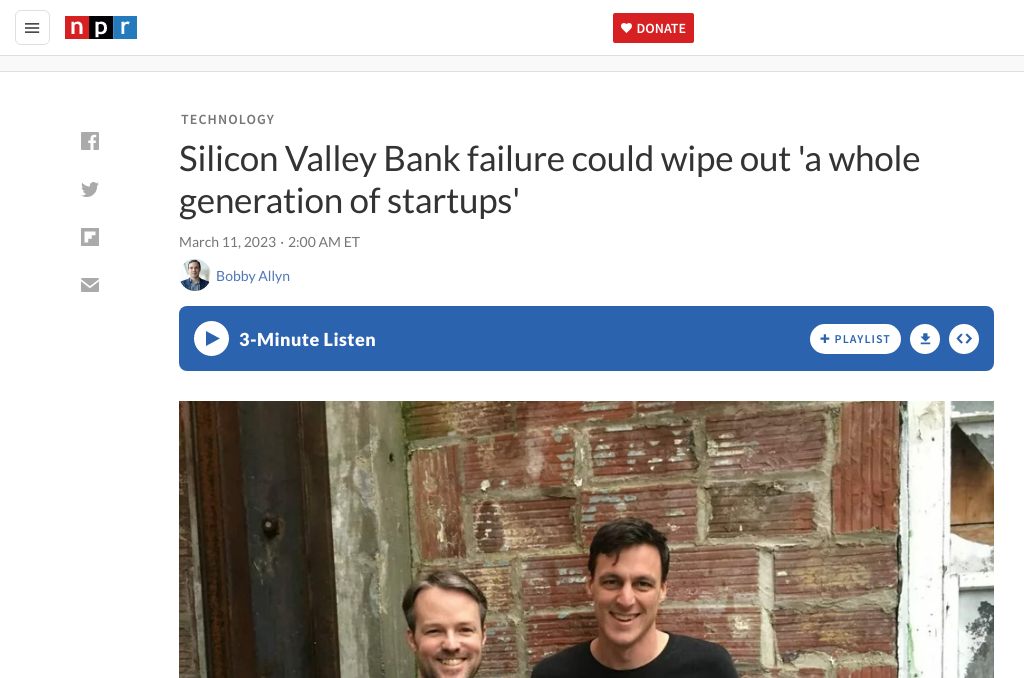The Silicon Valley Bank, one of the top-20 banks in the United States by asset size and a financial pillar in the tech and venture capital world, collapsed in a two-day stretch between March 8th and March 9th.[0] This marks the second-largest failure of a financial institution in US history, and the first since the financial crisis of 2008.[1] Silicon Valley Bank had connections with almost half of all U.S. venture-backed technology and healthcare companies, and investors such as Peter Thiel’s Founders Fund advised companies to pull their money from the bank.[2]
By Monday morning, the Federal Deposit Insurance Corporation (FDIC), an independent government agency which guarantees bank deposits and regulates financial institutions, promised that all insured depositors will be able to access their insured deposits in full.[3] It also said it would pay uninsured depositors an “advance dividend within the next week.”[4]
The cause of the bank’s failure can be attributed to a combination of weak risk management practices, a high proportion of large depositors not covered by FDIC, and the buying of long-dated securities when interest rates were low.[0] The bank’s failure was also the result of a “bank run,” which occurs when large numbers of depositors withdraw their money from a bank in a short period of time due to lack of faith in the bank.[5]
The Biden administration has stepped in to prevent this fear from becoming a contagion that could ripple through the whole banking system and launched the Bank Term Funding Program (BTFP) to provide one-year loans to other banks, savings associations, credit unions, and other eligible depository institutions with qualifying assets as collateral.[6]
Finally, the failure of Silicon Valley Bank and Signature Bank highlights just how fragile the banking system is. The speed with which news of Silicon Valley Bank’s impending demise spread, fueled by zero distribution costs for both rumors and withdrawals, was so destabilizing for an entity predicated on arbitraging time.[7] The FDIC’s $250,000 protection limit was not enough to protect many of Silicon Valley Bank’s customers, and the BTFP is a temporary solution that merely papers over the underlying problem.
0. “March 2023 Newsletter: A Look at Bank Solvency” Lyn Alden, 13 Mar. 2023, https://www.lynalden.com/march-2023-newsletter/
1. “A bailout or not? Did the federal government bailout Silicon Valley Bank and Signature Bank?” ABC News, 16 Mar. 2023, https://abcnews.go.com/Business/bailout-federal-government-bailout-silicon-valley-bank-signature/story?id=97846142
2. “Silicon Valley Bank failure could wipe out ‘a whole generation of startups’” NPR, 11 Mar. 2023, https://www.npr.org/2023/03/11/1162805718/silicon-valley-bank-failure-startups
3. “PR-16-2023 3/10/2023” FDIC, 12 Mar. 2023, https://www.fdic.gov/news/press-releases/2023/pr23016.html
4. “Takeaways from America’s second-largest bank failure” CNN, 11 Mar. 2023, https://www.cnn.com/2023/03/11/business/svb-collapse-roundup-takeaways/index.html
5. “Elon Musk says he’s ‘open to the idea’ of buying Silicon Valley Bank after its collapse — but is he really serious? Here …” Yahoo Life, 16 Mar. 2023, https://www.yahoo.com/lifestyle/elon-musk-just-said-hes-133500538.html
6. “Tiffany Dufu says SVP failure created a crisis for black-owned startups” NPR, 13 Mar. 2023, https://www.npr.org/transcripts/1163068280
7. “After Twitter played a massive role in a historic $42 billion bank run, Elon Musk mused it was like 1929” Fortune, 15 Mar. 2023, https://fortune.com/2023/03/15/twitter-role-in-svb-42-billion-bank-run-elon-musk-mused-it-was-like-1929/
